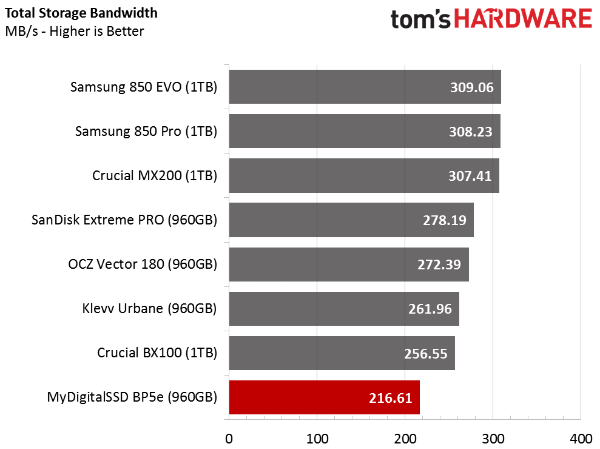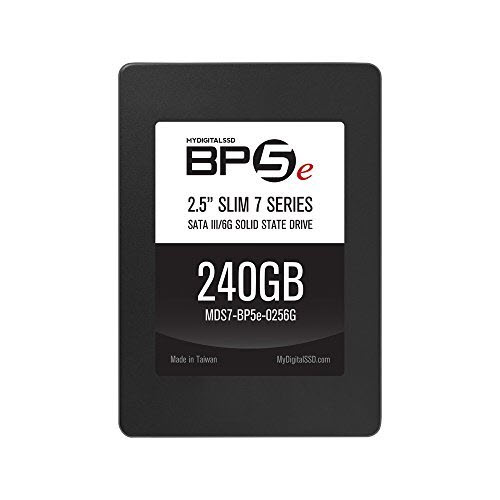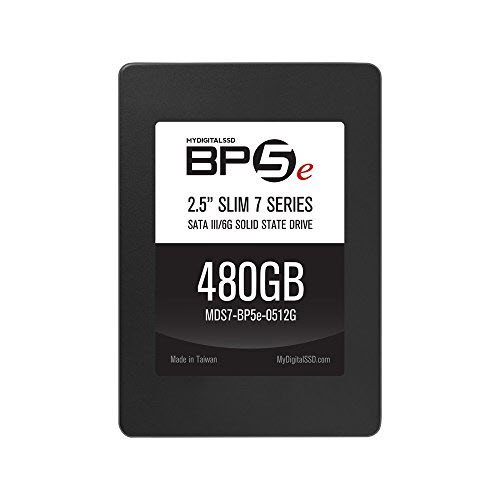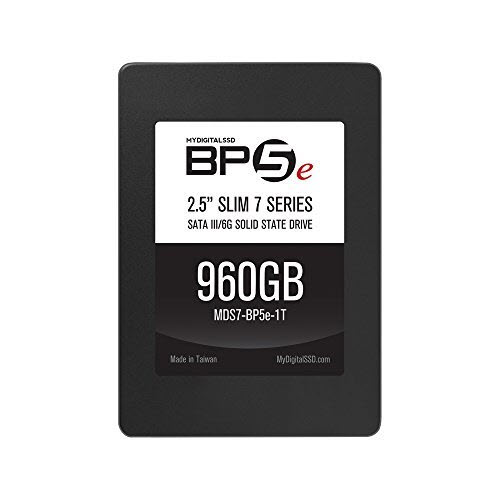MyDigitalSSD BP5e Low-Cost TLC SSD Review
Why you can trust Tom's Hardware
Real-World Software Performance
PCMark 8 Real-World Software Performance
For details on our real-world software performance testing, please click here.



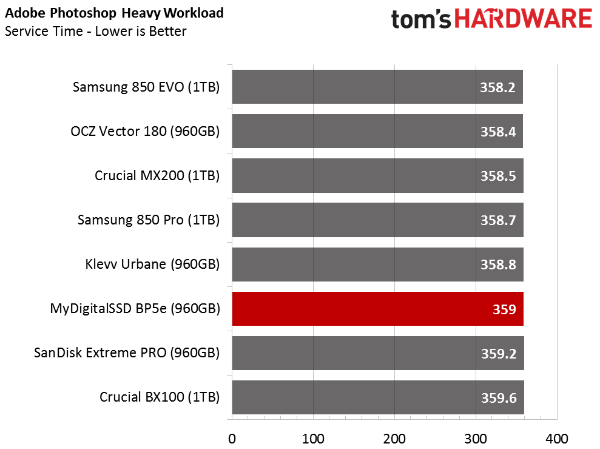
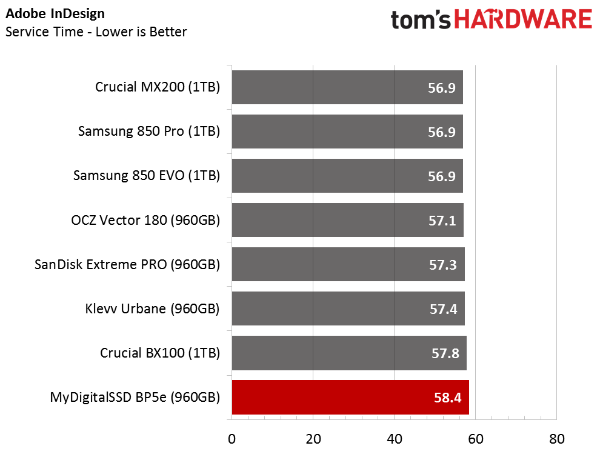
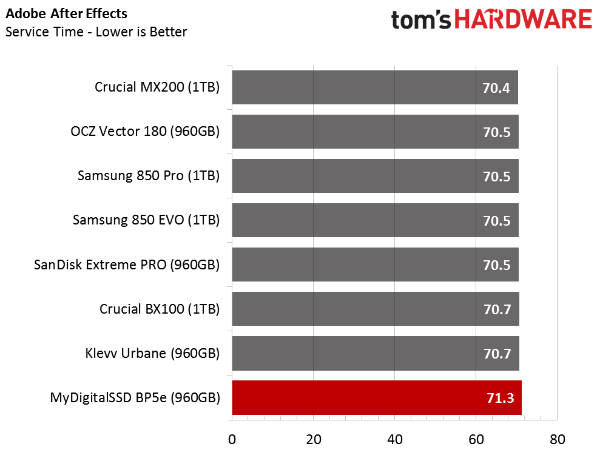
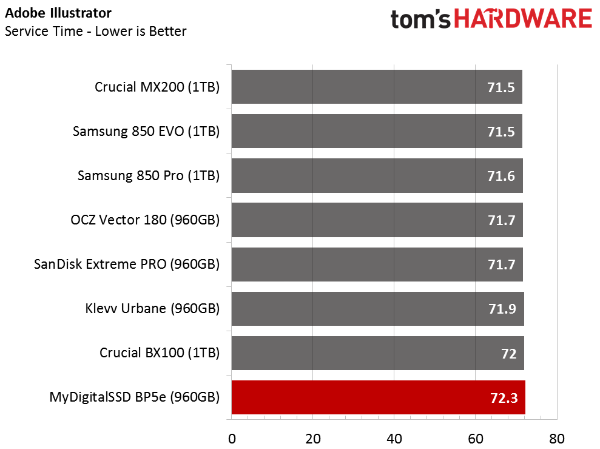
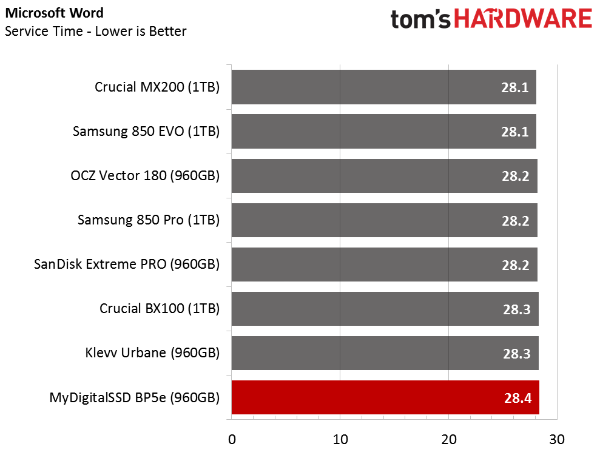
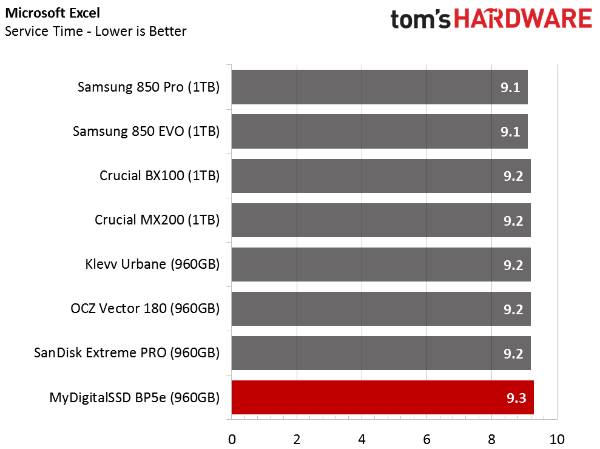

Other than Samsung's 1TB 850 EVO, the 960GB BP5e is the only other TLC-based SSD on our charts. The 850 EVO is a mainstream drive, not a true entry-level contender. With that in mind, it's hardly surprising to see MyDigitalSSD's offering trailing most of the other products we're comparing it to. When you take price into consideration, the BP5e holds up pretty well.
Total Storage Bandwidth
When you look at the combined results in throughput, the BP5e only trails Crucial's BX100 1TB by a small margin. The BX100 was a popular low-cost SSD from the time it was released last April until it was discontinued at the end of November. It launched at $375, and its price crept up to $399 where it sits now. In contrast, the somewhat slower BP5e sells for $240.
PCMark 8 Advanced Workload Performance
To learn how we test advanced workload performance, please click here.
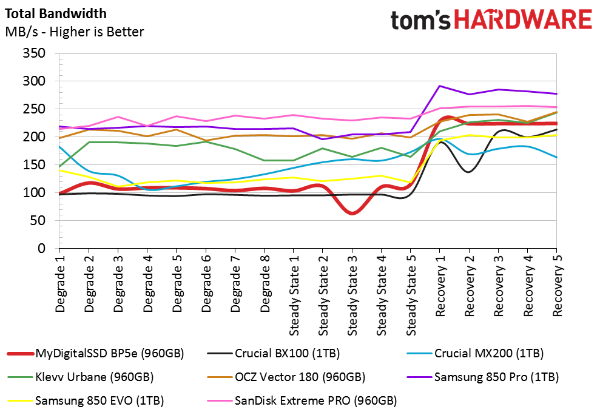
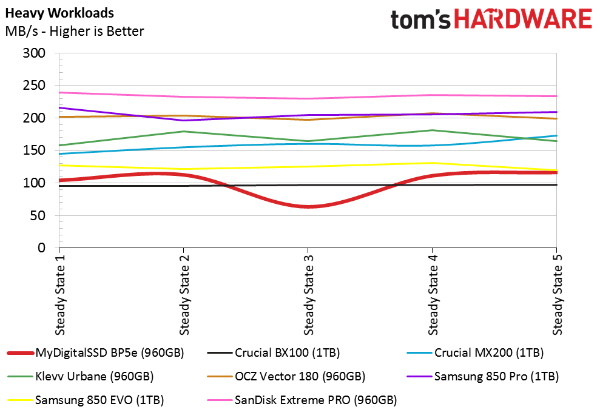
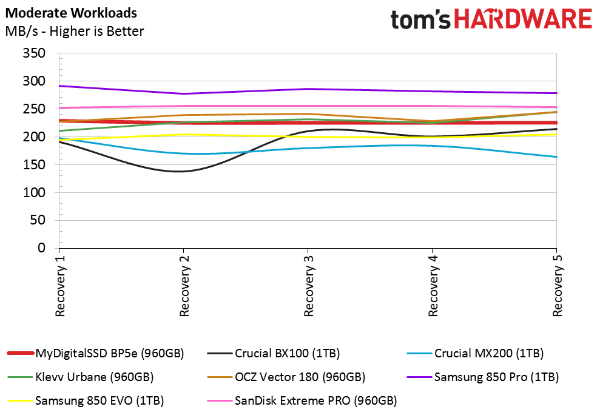
Given the BP5e's strong emphasis on low cost, we're not too worried about how it fares under heavy workloads. Of the drives tested, it falls somewhere in the middle when we hit it with moderately-demanding benchmarks. In this test environment, drives have less time to recover. Some manufacturers perform background clean-up activities on their drives right away, while others wait until the last few pages are dirty. When clean-up begins, latency increases, reducing measurable throughput. The S10 controller's core count advantage helps under these conditions, nudging the BP5e upon our chart to outperform generally faster SATA SSDs.
Service Time

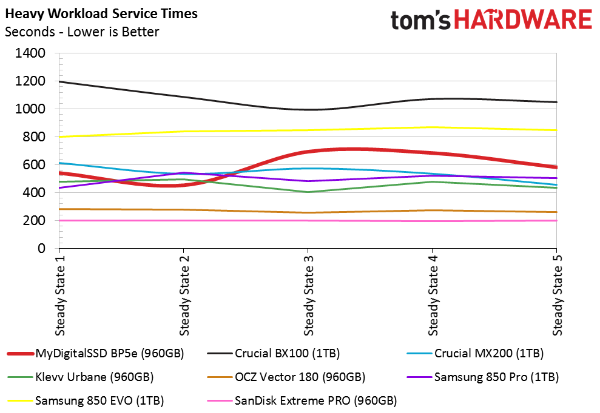
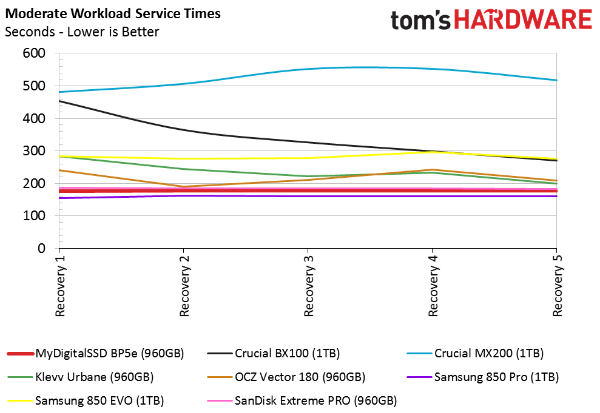
This is where we really get to the benefit of four cores under moderate workloads (we're also mimicking what performance is like when the drive is almost full). Gamers who install everything to their boot drive should think about this before buying an SSD. after all, nobody snags a 1TB-class drive to leave it mostly empty.
Notebook Battery Life
For more information on how we test notebook battery life, click here.
Get Tom's Hardware's best news and in-depth reviews, straight to your inbox.

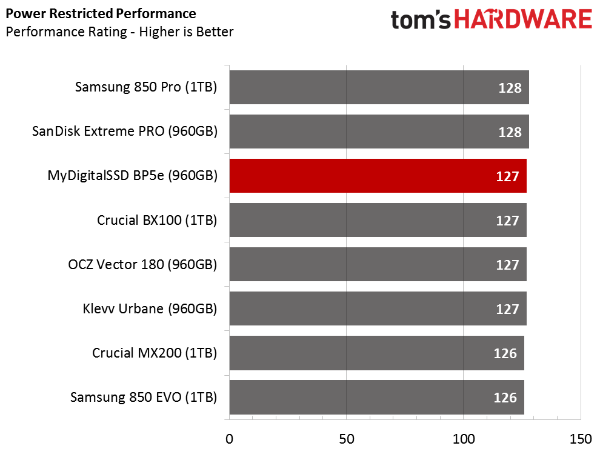
It's hard to complain about the battery life numbers turned in by the BP5e, but we did expect a little more. We've come to understand that drives with emulated SLC caches tend to fare a little better than straight MLC-equipped SSDs. SanDisk's Extreme Pro—shown at the top of the chart—is a good example. It uses a proprietary SanDisk technology called nCache, which is basically a single-level cell buffer.
Current page: Real-World Software Performance
Prev Page Mixed Workloads And Steady State Next Page Conclusion
Chris Ramseyer was a senior contributing editor for Tom's Hardware. He tested and reviewed consumer storage.
-
That price is incredible. I remember my first SSD, when it was ONLY 2$/GB. If I was buying today, I'd get 6 * 480 GB drives, and run them in a btrfs raid, just for plain storage. For anyone buying today, for their own use, it makes no sense to go mechanical.Reply
Can't wait for the next generation Samsung 3d nand. -
Nintendork It makes no sense to raid 0 SSD's, you won't improve random 4k performance AND YOU WONT IMPROVE LATENCY (wich is what it makes SSDs faster than a HDD). You're simply adding more fail %.Reply
NVMe SSD's barely improve those things. We will need intel's 3D Xpoint (or similar tech) for another massive gain in those things.
-
cryoburner ReplyFor anyone buying today, for their own use, it makes no sense to go mechanical.
The price might be relatively good for an SSD, but that's still 25 cents per gigabyte. Mechanical desktop drives, by comparison, are generally around 3 to 5 cents per gigabyte, which for someone needing multiple terabytes for bulk storage or backup redundancy can really add up. For many purposes like storing video, there won't be much of a performance difference either.
Of course, most people probably don't even need 1 TB of storage in their system, and 240 GB of storage could be more than enough for them, in which case doing away with a mechanical drive in favor of a comparably priced but lower-capacity SSD could make a lot more sense. -
CalHob Interesting to see TLC continuing to lead the value market with further refinement of error correction technique while still developing improvements in performance.Reply
As a REVIEW, it comes up short in evaluting against products in the same performance and price segment. As I started to read the review, I kept looking for Tom's Best Pick 1TB Budget Buy, the Mushkin Reactor, to be included. And, there are also other TLC based drives, that Tom's has reviewed in other capacities, that should be included. In my mind, the review should have included at a minimum: Samsung 850 EVO 1 TB (as the TLC performance reference), ADATA SP550 960GB, and Mushkin Reactor 1TB. At this point in time, the MyDigitalSSD, ADATA and Mushkin drives are competing at the same price point on Amazon and Newegg. Comparing these drives would have brought more meaning to the review. -
photonboy Nintendork,Reply
There are reasons to RAID0 an SSD. For example, working with video can benefit. Plenty of articles with number to prove that, and also to prove that for MOST things real-world benefits aren't there. -
rhysiam How likely is it that other Phison S10 drives have benefited significantly from performance-related firmware updates since release? It seems like this drive is better than the competition primarily because of the more mature firmware, but I'm wondering if other drives have also improved since release.Reply -
CRamseyer ReplyInteresting to see TLC continuing to lead the value market with further refinement of error correction technique while still developing improvements in performance.
As a REVIEW, it comes up short in evaluting against products in the same performance and price segment. As I started to read the review, I kept looking for Tom's Best Pick 1TB Budget Buy, the Mushkin Reactor, to be included. And, there are also other TLC based drives, that Tom's has reviewed in other capacities, that should be included. In my mind, the review should have included at a minimum: Samsung 850 EVO 1 TB (as the TLC performance reference), ADATA SP550 960GB, and Mushkin Reactor 1TB. At this point in time, the MyDigitalSSD, ADATA and Mushkin drives are competing at the same price point on Amazon and Newegg. Comparing these drives would have brought more meaning to the review.
When Adata released the SP550 drives for review the 960GB model was not ready. We simply do not have that drive. We built a low cost SSD performance database for each of the other capacity sizes and you see similar products grouped together in those reviews. From Computex (last June) until only recently many of the TLC-based drives were not available. In short, we're working on it.
This review was put together before the OCZ Trion 150 arrived, the two new PNY drives, the new Corsair LE and the stuff we can't talk about yet (but soon).
The Best of Monthly (what I call it) goes back to being a monthly release starting this week. Several of you read and comment on my reviews so you are here quite a bit. I plan to utilize the monthly column to recap the reviews for the month and give some insight into what to expect for the next month. I've also added several new columns. Expect to see entry-level, mainstream, and premium drives for each capacity as well as new PCIe and All-in-One RAID drives.
-
razor512 Minimal price reduction for a massive reduction in write endurance. It is a bad value unless they can reduce their price by at at least 40% (to match the data density gains that they get from TLC).Reply -
FilipHappy ReplyWhen Adata released the SP550 drives for review the 960GB model was not ready. We simply do not have that drive. We built a low cost SSD performance database for each of the other capacity sizes and you see similar products grouped together in those reviews. From Computex (last June) until only recently many of the TLC-based drives were not available. In short, we're working on it.
This review was put together before the OCZ Trion 150 arrived, the two new PNY drives, the new Corsair LE and the stuff we can't talk about yet (but soon).
The Best of Monthly (what I call it) goes back to being a monthly release starting this week. Several of you read and comment on my reviews so you are here quite a bit. I plan to utilize the monthly column to recap the reviews for the month and give some insight into what to expect for the next month. I've also added several new columns. Expect to see entry-level, mainstream, and premium drives for each capacity as well as new PCIe and All-in-One RAID drives.
Even though - good job! The review is useful and one gets a nice overall view. Thank you. :)
May I ask for your personal opinion? As a budget 1TB SSD - would you buy Mushkin Reactor 1TB, MyDigitalSSD BP5e 960GB, Adata SP550 960Gb, or wait for new releases (or wait even until june)? -
George_71 I hope "mydigitalssd" has finally gotten their stuff together. I bought a BP4e mSATA drive about a year or so ago. It failed constantly. I contacted "mydigitalssd", RMAed the drive. MDSSD replaced the drive. The replacement drive has the same issues.Reply
There is a cost/benefit that needs to be taken into account when dealing with drives. This is a low cost option,however do you really want to take the chance? I am sorry i did.
